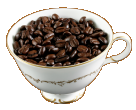Learn more about your own coffee cellar
For coffee romantics, coffee pantry has a fine ring to it. It resonates with the same combined pleasure of connoisseurship and security that motivates people to keep piles of dusty wine bottles piled deep in the basements of their homes.
Correct storage for green coffees is cool but not cold, dark, dry, and, above all, well vented. Rather than cellar, think pantry. The storage cupboards in the kitchens of older houses, the kind that allow air to circulate among the shelves, represent an ideal environment in which to store green coffee.
Good, high-grown green coffees (Central American, Colombian, East African) kept in such conditions will change very little over two or three years. For the first year or so they will round and sweeten in flavor, than become fuller in body but gradually lose brightness and acidity.
Lower-grown, gentler coffees may change in flavor rather drastically. Brazilian Santos, for example, may begin to lose acidity as soon as six months after harvest and after a year or so often develops a flat, mildew taste professional cuppers call baggy.
In what kind of container should you store your coffee? Plastic bags are fine for short-term storage when setting up a coffee pantry, but if you plan to hold a coffee for more than a month or two you should transfer it to something porous. Cloth is beyond question best, but corrugated cardboard boxes probably work as well.
Burlap bags of the kind used to construct temporary levees during periods of flood are ideal for storing coffee at home. They are sold empty; they are a convenient size (not trivially petite yet still luggable when full); and they include sewn-in drawstring closures. You can find them in obscure industrial parts of cities; look in the Yellow Pages under “bags.” Buy the cloth bags, not the plastic.
Green coffee is a living entity; it needs to breathe. Elevate the boxes or bags on a pallet or similar arrangement that allows air to circulate beneath them. Every few months shift the containers around. Turn them over, and if they are in a pile, shift the bottom containers toward the top of the batch and bring the top ones down, much as you would rotate tires on a car.
Fortunately for those of us who are tired of restaurants gotten up as tacky imitations of wine cellars, there is no symbolic architecture associated with storing coffee beyond a simple warehouse filled with burlap of coffee bags piled on pallets. So when it comes to the interior design aspects of you coffee cellar (or coffee pantry), you are on your own.
To achieve the more dramatic effect gotten by deliberate aging coffee at home as it is practiced in Singapore, you need a warm, humid climate. Those in the tropics may want to store some coffee in cloth bags in the carport, rotate the bags once in a while, and taste the result after a year or two. The goal here is lots of humidity but no direct contact with rain or moist concrete, which should net you a coffee with a little acidity, heavy body, and varying degrees of a leather, roughly musty flavor.
Find more resources and tips relating to keurig coffee maker.
Categories: Coffee Articles Tags: Brazilian Santos, Central American, East African, Yellow Pages


